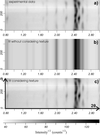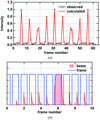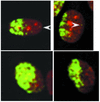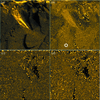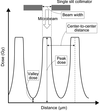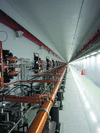issue contents
July 2011 issue

Cover illustration: Volume rendering of inline phase-contrast tomography data showing the head of a mosquito (genus Anopheles). The phase reconstruction of this data set was performed using the single-distance phase-retrieval computer program ANKAphase (see Weitkamp, Haas, Wegrzynek and Rack, pages 617-629). Three-dimensional images of this kind allow biologists to study morphological differences between individual animals or different species.
facility information
research papers
The picosecond emission at ANKA, in both the THz and the X-ray regime, is employed for time-resolved experiments.
The design and operation of a differential pumping system on a bending magnet beamline is reported. This system allows vacuum ultraviolet (VUV) photons down to 60 nm to be delivered at atmospheric pressure.
A method is presented obtaining detailed information about the preferred orientation as well as the anisotropy of physical properties (e.g. elastic modulus or thermal expansion) from two-dimensional diffraction images of crystalline human dental enamel.
An approximate Ba L3 atomic background, exhibiting a prominent 2p4d resonance, is extracted from the L subshell EXAFS spectra of hydrated Ba2+ ions. The application of the background to weak L3 EXAFS spectra of Ba hexaferrite nanoparticles is analyzed.
Open  access
access
 access
accessThe use of multiple, oriented and singly referenced objects was evaluated as a means to overcome the low scattering cross section inherent in hard X-ray Fourier transform holography. It is shown that the image of each object can be restored as in the conventional single-object case.
Open  access
access
 access
accessAn X-ray stereo imaging system with synchrotron radiation was developed to perform real-time stereo imaging and stereo angiography.
Open  access
access
 access
accessA nested Kirkpatrick–Baez mirror pair has been designed, fabricated and tested for achromatic nanofocusing synchrotron hard X-rays. The prototype system achieved a FWHM focal spot of about 150 nm in both horizontal and vertical directions.
Open  access
access
 access
accessCoherent X-ray diffraction techniques play an increasingly significant role in imaging nanoscale structures which range from metallic and semiconductor samples to biological objects. The conventional knowledge about radiation damage effects caused by ever higher brilliance X-ray sources has to be critically revised while studying nanostructured materials.
Open  access
access
 access
accessAn automated loop-centring program and a high-precision goniometer head used at the Swiss Light Source are described.
Open  access
access
 access
accessThe decay time of YAG:Ce3+ scintillator was estimated to be 60 ns by using a fast CMOS camera and synchrotron bunches.
Open  access
access
 access
accessA design is presented for a cryogenically stabilized monochromator for 10–40 keV synchrotron radiation that uses six crystal reflections to achieve a meV-bandpass with high efficiency.
A novel X-ray molecular targeting probe using superparamagnetic iron oxide conjugated with arginine–glycine–aspartic acid has been developed; tumor angiogenesis can be targeted in vivo.
ANKAphase: software for single-distance phase retrieval from inline X-ray phase-contrast radiographs
ANKAphase is a computer program that processes X-ray inline phase-contrast radiographs by reconstructing the projected thickness of the objects imaged. The program uses a single-distance non-iterative phase-retrieval algorithm described in a paper by Paganin et al. [(2002), J. Microsc. 206, 33–40].
Open  access
access
 access
accessThe molecular response of mammalian cells to a monoenergetic synchrotron X-ray microbeam which emulated microbeam radiation configurations has been investigated. Very few γH2AX foci were found outside the irradiated zone within 1 h of irradiation, even within a single nucleus. Furthermore, 12 h after radiation there was a large decrease in foci number but many cells still contained γH2AX foci, of which many were outside the directly irradiated regions.
The overall design, commissioning and early results from a position-sensitive detector, constructed using MYTHEN-II detection modules, for fast time-resolved X-ray powder diffraction on beamline I11 at Diamond Light Source is described.
Scanning photoemission microscopy is applied to the surfaces of homogeneous and heterogeneous chalcopyrite (CuFeS2).
The recently completed commissioning of an upgraded undulator-based beamline at BioCARS, a national user facility for macromolecular time-resolved X-ray crystallography at the Advanced Photon Source, is described.
Open  access
access
 access
accessA narrow microbeam is shown to be more effective than a wide microbeam for microbeam radiation therapy.
short communications
A method for removing Zn (Z = 30) Raman background emission from Cu (Z = 29) fluorescence EXAFS data is described.
beamlines
A description of the CMCF 08ID-1 beamline at the Canadian Light Source is presented along with recent science highlights.
addenda and errata
Free 

An acknowledgment is published for the paper by Nguyen et al. [(2011), J. Synchrotron Rad. 18, 475–480].
current events
Free 



 journal menu
journal menu

















